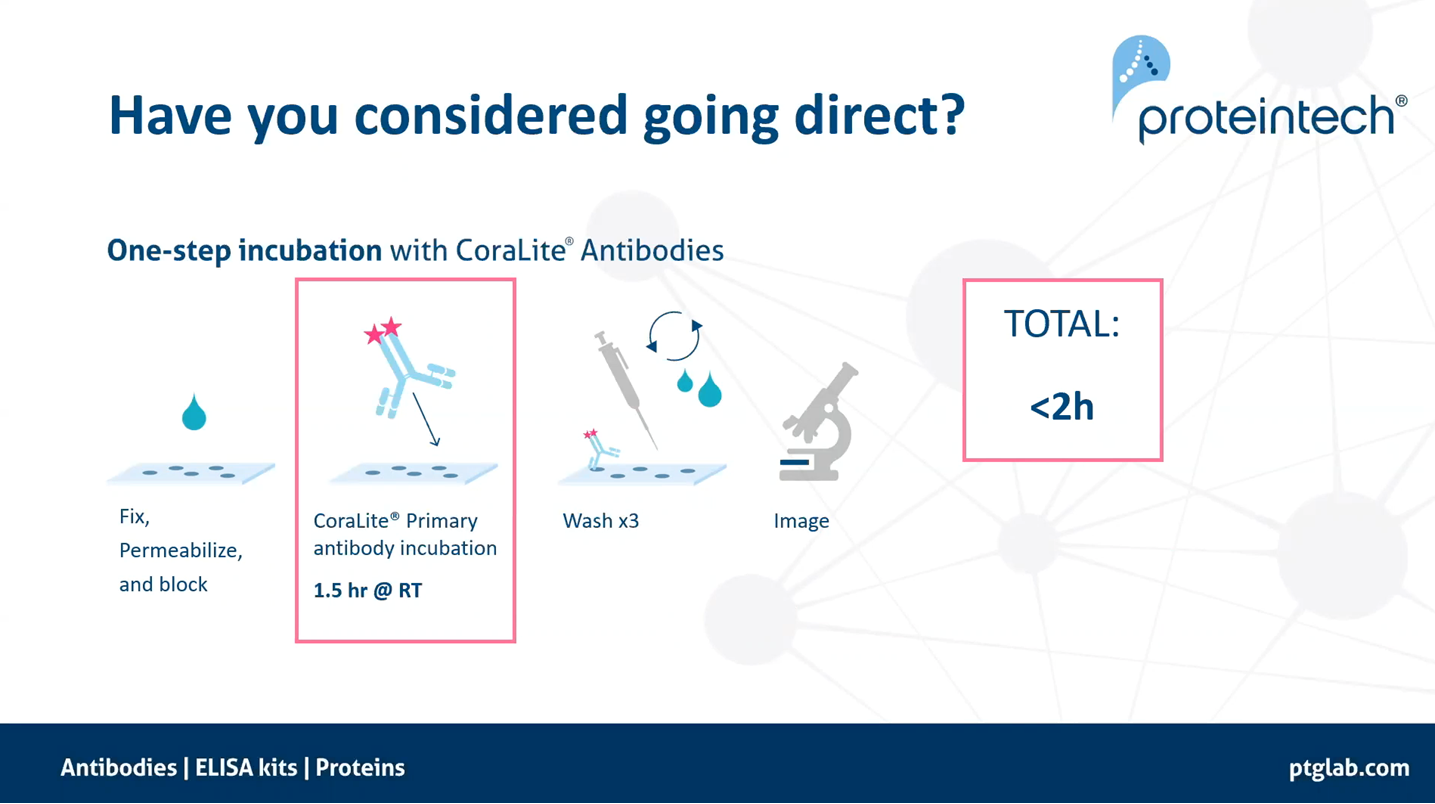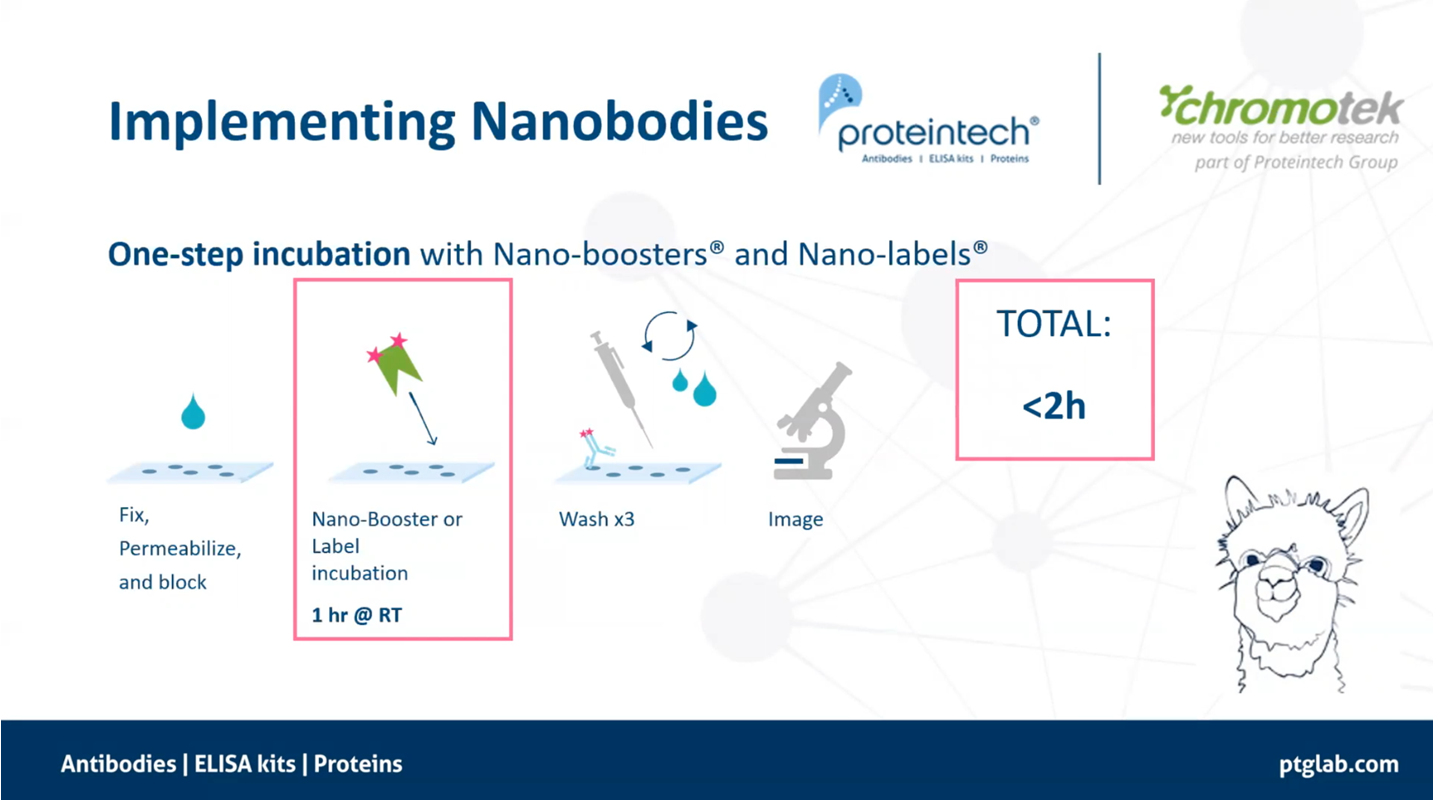Save time on your immunofluorescence experiments
Save time on your immunofluorescence (IF) experiments
Video Transcription
Hi everyone, and welcome to our tiny technical talk on How to Save Time on Your Immunofluorescence Experiments. My name is Rebecca Northeast and I'm the technical specialist here at Proteintech.
Due to the ongoing situation across the globe, many researchers are now short on time in the lab and having to work in shifts or allocated time slots, meaning that they have much-reduced access to equipment. This is on top of an already busy life of an academic with grant applications, student mentoring, and manuscripts admissions, to name just a few.
The traditional immunofluorescence workflow can take a long time with your overnight incubation of your primary antibody and your secondary antibody incubations requiring multiple sequential days in the lab, taking up to a total of one and a half days.
With the majority of immunofluorescence experiments, primary antibody incubation can instead be done at one and a half hours at room temperature. This is more than enough time to allow for specific antibody binding. And you may also find that shorter incubations result in decreased background. A shorter room temperature incubation results in the whole experiment now only taking around three to four hours.
But have you considered going direct? We can shorten our IF protocol even further by utilizing directly conjugated primary antibodies, such as our CoraLite antibodies. This negates the use of a secondary antibody, and so saves further wash and incubation steps resulting in the whole experiment now taking less than two hours. This means that you now have more time for other research projects or a well-deserved cup of coffee.

So, what are CoraLite antibodies? These are our popular monoclonals which have been conjugated to our CoraLite synthetic dyes. And how does CoraLite compare to other synthetic dyes such as Alexa Fluor? Well, these are the exact equivalent of Alexa dyes in brightness, stability, and size, meaning that they are bright, stable and small. We have over 400 targets directly conjugated to CoraLite dyes, and we are constantly adding to our portfolio.
Directly conjugated antibodies are great for abundant targets, such as cytoskeletal markers, organelles, or other cell markers such as TUBB3. The lack of a secondary antibody results in images with less background as it negates any non-specific binding from the tagged secondary antibody.
As well as directly conjugated antibodies, with our partner company ChromoTek, we now sell Nano-Boosters and Nano-Labels which are the VHH binding domain from alpaca heavy-chain antibodies, which are then recombinantly produced and conjugated with Alexa Fluor or ATTO dyes. These are excellent when looking at GFP-tagged proteins. And like with the CoraLites, using Nano-Boosters can save you much time in your immunofluorescence experiments.

So what are Nano-Boosters and Nano-Labels used for? For example, tissue-clearing experiments in genetically tagged animals with GFP, the small size of the Nano-Booster allows for increased tissue penetration. Nano-Boosters are also excellent for super-resolution microscopy because their small size allows for minimal fluorophore displacement providing incredibly precise imaging.
So our take-home message from this short talk is that there are many ways to save time in your immunofluorescence experiments. Try a shorter, at-room temperature incubation of primary antibody instead of overnight. You can try our directly conjugated primary antibodies, which are great for abundant targets and can save you more time and provide higher, cleaner imaging. Nanobody technology can also save you time and provide incredibly high-resolution images due to their small size and vastly decreased fluorophore displacement.
Just a quick note about Proteintech. We have been original manufacturer of antibodies, ELISA kits, and proteins since 2001. We have antibodies against 13,000 human targets, two and a half thousand of which have been validated with knockdown and knockout validation. In 2020, we acquired ChromoTek, a leading manufacturer of nanobody technologies. We also sell human cell-expressed cytokines and growth factors within our HumanKine range, plus our CoraLite conjugated antibodies which I have already spoken about today. And as of today, we have over 90,000 product citations.
Thank you so much for listening. Please email me at rebecca@ptglab.com if you have any questions.




